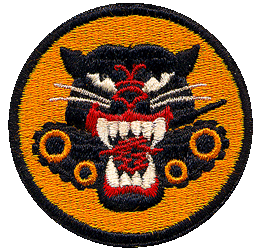Unit History: Originally the 101st New York National Guard Antitank Battalion, which was federalized on 6 January, 1941, and redesignated as the 801st Tank Destroyer Battalion on 15 December. Arrived in England as a towed battalion, 11 March, 1944. Landed at Utah Beach on 13 June and participated in capture of Cherbourg. Fought at Mortain in early August, reaching outskirts of Paris on 25 August. Entered Belgium on 8 September and Germany on 12 September. Supported operations in the Hürtgen Forest beginning late November. On the line in Ardennes when German offensive struck on 16 December. Moved to Aachen, Germany, in February 1945. Crossed Roer River on 25 February and reached the Rhine River south of Düsseldorf. Crossed Rhine near Wessel on 29 March, supported drive to the Ruhr and then turned east to the Elbe River. Transferred south and supported operations in Harz Mountains in late April. Converted to M18’s in late April. Crossed Danube and reached Inn River, outside Hitler’s birthplace, Brunnau, Austria, by VE Day. Attached to: 2d, 13th Armored divisions; 2d, 4th, 9th, 83d, 99th Infantry divisions. History text from the book The Tank Killers by Harry Yeide. Used by permission.
Combat Equipment: 6/44 – Towed 3″ Gun; 4/45 – M18
Commanding Officers: Major Ralph A. Glatt (Orig. CO); Major Harry C. Larter (Feb, 42); Lt Col. Elmer B. Horsfall (Oct, 42 as a Major); Maj. Robert I. McKesson (1/45)
Code Name/s: Cannon
Campaign Credits: Normandy…………………..Jun. 6, to Jul. 24, 1944
Northern France……………Jul. 25, to Sept. 14, 1944
Rhineland……………………Sept. 15, 1944 to Mar. 21, 1945
Ardennes-Alsace…………..Dec. 16, 1944 to Jan 25, 1945
Central Europe……………..Mar. 22, to May 11, 1945
Awards: Croix De Guerre (French or Belgium “Cross of War”)
Location August 1945: Steinheim, Germany
Additional Information/Materials:
1.) Origin & History – A short history with four maps of the unit’s route through England and Europe. Courtesy of the Tank Destroyer Association by L. L. Gill, TDA Historian.
2.) After Action Reports – from the Combined Arms Research Library of the Command and General Staff College, Fort Leavenworth, Kansas and the Dwight D. Eisenhower Presidential Library, Museum and Boyhood Home, Abilene, Kansas (*).
June 13-30, 1944…………..2 Pages
July 1-31, 1944……………..2 Pages
Aug. 1-31, 1944……………3 Pages (Includes casualties and awards) (*)
Sep. 1-30, 1944…………….5 Pages (Includes casualties and awards) (*)
Oct. 1-31, 1944…………….6 Pages (Includes awards) (*)
Nov. 1-30, 1944……………3 Pages
Dec. 1-31, 1944…………….7 Pages
Jan. 1-31, 1945……………..2 Pages
Feb. 1-28, 1945…………….3 Pages (Poor quality)
Apr. 1-May 4, 1945………10 Pages
Apr. 25-May 4, 1945………4 Pages (Includes officers roster)
Apr. 1-May 4, 1945………..2 Pages (S-2 Summary)
Apr. 1-May 4, 1945………..2 Pages (S-3 Summary)
Apr. 1-May 4, 1945………..1 Page (S-4 Summary)
April 1945……………………3 Pages (History report, includes casualty and awards listing.)
3.) Monthly Unit History – from the Dwight D. Eisenhower Presidential Library, Museum and Boyhood Home, Abilene, Kansas.
June 1-30, 1944…………….2 Pages
4.) Miscellaneous Documents – from the Dwight D. Eisenhower Presidential Library, Museum and Boyhood Home, Abilene, Kansas.
Various Documents, 1941-1942……..5 Pages
5.) Group Photo HQ Company – Taken at Camp Sutton, North Carolina, on May 16, 1942. This photo includes some of the unit’s M3 Tank Destroyers in the background. Provided courtesy of Paul Stevens.
6.) Group Photo B Company – Taken at Fort Benning, Georgia, in January of 1942. Provided courtesy of Paul Stevens.
7.) Photo Gallery
8.) Journal of HQ Company Clerk – In addition to the many official documents that Cpl. Jack E. Huff would have been responsible for, he also kept a private journal, which not only included his pay records but also names and dates of places the unit was stationed and a comprehensive list (Roster) of the men he served with in HQ Company. There is even a list of some addresses for a few of the men that he wrote to after the war.
